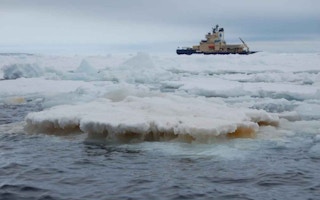As the planet’s oceans become more acidic, the diatoms − a major group of alga − in the Southern Ocean could grow more slowly.
Nobody expected this. And since tiny, single-celled algae are a primary food source for an entire ocean ecosystem, the discovery seems ominous.
Bioscientist Clara Hoppe and colleagues from the Alfred Wegener Institute [http://www.awi.de/en/home/] at the Helmholtz Centre for Polar and Marine Research in Bremerhaven, Germany, report in the journal New Phytologist that they tested the growth of the Antarctic diatom Chaetoceros debilis under laboratory conditions.
They used two levels of pH – which is an indicator of acidity – and they exposed their tiny volunteers to constant light and to changing light, providing both standard laboratory conditions and lighting levels that approximated to the real world.
“
Ocean acidification has already cost the oyster industry in the Pacific Northwest nearly $110 million and has jeopardised about 3,200 jobs
Julia Ekstrom, director of the Climate Adaptation Programme at the University of California, Davis
Plant growth
In the unblinking glare of light, the diatoms responded well. Their growth levels were consistent with an assumption that more dissolved carbon dioxide – which makes the waters more acidic – would in effect fertilise plant growth.
Under conditions of changing light, however, it was a different story. The algae grew more slowly, which suggests that the oceans could become less efficient at removing carbon from the atmosphere, and perhaps less valuable as a primary food source for the creatures that teem in the Antarctic waters.
“Diatoms fulfil an important role in the Earth’s climate system,” Dr Hoppe says. “They can absorb large quantities of carbon dioxide, which they bind before ultimately transporting part of it to the depths of the ocean.
“Once there, the greenhouse gas remains naturally sequestered for centuries.”
Previous research into the steady acidification of the oceans has tended to concentrate on the consequences for coral reefs, fisheries, and tourism, but not on the impact on plant life in the seas.
Since carbon dioxide acts as a fertiliser, higher levels dissolved in the water might stimulate more growth.
But growth depends not just on more carbon dioxide, but also on reliable sunlight. In the stormy southern seas, this is not steadily supplied.
Dr Hoppe says: “Several times a day, winds and currents transport diatoms in the Southern Ocean from the uppermost water layer to the layers below, and then back to the surface – which means that, in the course of a day, the diatoms experience alternating phases with more and with less light.”
Her co-author, marine biogeochemist Björn Rost, from the Alfred Wegener Institute, says: “Our findings show for the first time that our old assumptions most likely fall short of the mark. We now know that when the light intensity constantly changes, the effect of ocean acidification reverses.
“All of a sudden, lower pH values don’t increase growth, like studies using constant light show. Instead, they have the opposite effect.”
The implication is that, at certain intensities, the photosynthesis chain breaks down. The point at which light becomes too much light is more quickly reached in waters that are more acidic.
Like all such research, the finding has limitations. It applies to one species of single-celled creature in the waters of one ocean, and the tests were in a laboratory on a small scale, and not in a turbulent ocean rich in life. The Alfred Wegener team will continue their studies.
But in the real world, coastal communities in 15 US states could be at long-term economic risk, as ocean acidification starts to take its toll on the commercial oyster fisheries.
Julia Ekstrom, then of the Natural Resources Defense Council and now director of the Climate Adaptation Programme at the University of California, Davis, and George Waldbusser, assistant professor of ocean ecology and biogeochemistry at Oregon State University report with colleagues, in Nature Climate Change, on an unholy mix in the oceans.
Fisheries at risk
They say that a combination of rising greenhouse gas levels, more acid waters, polluted rivers, and upwelling currents put at risk mollusc fisheries from the Pacific Northwest, New England, the Mid-Atlantic states and the Gulf of Mexico – affecting the shellfish industry that is worth at least $1bn to the US.
Oyster larvae are sensitive to changes in ocean water, and more likely to die as pH levels shift towards the acidic.
But acidification is not the only source of stress, as nitrogen-rich nutrients and chemical pollutants cascade from the land into the rivers, and wash through estuaries and fish hatcheries on the coast.
Things can be done. Scientists have been looking at ways in which the industry might be able to adapt to change. But how well the oyster stock can adapt in the long term remains problematic.
“Ocean acidification has already cost the oyster industry in the Pacific Northwest nearly $110 million and has jeopardised about 3,200 jobs,” Dr Ekstrom says.
And Dr Waldbusser adds: “Without curbing carbon emissions, we will eventually run out of tools to address the short term, and we will be stuck with a much longer-term problem.”










